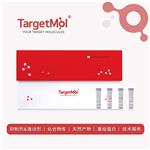Also available: fractionated dermatan sulfates with Av. Mw 25,000 ± 2,500 and 50,000 ± 5,000 and different Anti-Xa and Anti-IIa activities. Please inquire
Chondroitin sulfate B may be used to study its roles as a biomolecule receptor, mediator of cell signaling and cell binding molecule. It may be used to compare its properties to those of chondroitin sulfate A and chondroitin sulfate C. Chondroitin sulfate B is used to study β peptide(1-42) cytotoxicity.
ChEBI: Dermatan sulfate polyanion is the conjugate base of dermatan sulfate, obtained by deprotonation of carboxy and sulfate groups. It is a monocarboxylic acid anion, an organosulfate oxoanion and a polyanionic polymer. It is a conjugate base of a dermatan sulfate.
Chondroitin, a glucosaminoglycan (GAG), is a polysaccharide chain of alternating units of N-acetylgalactosamine (GalNAc) and glucuronic acid (GlcA) that can be sulfated on the either or both GalNAc and GlcA units. Chondroitin and its sulfates are frequently attached to proteins to form proteoglycans. Chondroitin sulfate B (Dermatam sulfate) is a component of proteoglycans such as decorin, biglycan and versican. Chondroitin sulfate B is used to study β peptide (1-42) cytotoxicity.
As a large, negatively charged, hydrophilic molecule that is too inflexible to fold into a compact globular structure, chondroitin sulfate molecules form porous hydrated gels, providing mechanical support to tissue and allowing rapid diffusion of water-soluble molecules and migration of cells.
Dermatan sulfate is purified by digestion with papain and hyaluronidase, and fractionation using aqueous EtOH. [Gifonelli & Roden Biochemical Preparations 12 1 1968.]
